Recent Storm Damage Posts
Storm Preparedness: Stocking Up on Essential Emergency Supplies
1/9/2024 (Permalink)
In the face of unpredictable and potentially severe weather events, storm preparedness is a must for every household. Having a well-equipped emergency kit can make all the difference in ensuring your safety and well-being during and after a storm. In this blog, we'll explore the essential emergency supplies you should have on hand to weather any storm.
1. Water
Adequate water supply is at the top of the list for emergency preparedness. Ensure you have at least one gallon of water per person per day for at least three days. This will cover drinking, cooking, and hygiene needs.
2. Non-Perishable Food
Stock up on non-perishable food items that require little to no preparation. Canned goods, granola bars, nuts, and dried fruits are excellent choices. Make sure to have enough to sustain your family for at least three days.
3. First Aid Kit
A comprehensive first aid kit is essential for addressing minor injuries and providing basic medical care. Include bandages, antiseptic wipes, pain relievers, prescription medications, and any specific medical supplies your family may need.
4. Flashlights and Batteries
Power outages are common during storms, so having reliable light sources is crucial. Invest in high-quality flashlights and a supply of batteries to keep them running. Consider LED flashlights for longer battery life.
5. Portable Phone Charger
Keep your communication devices charged with a portable phone charger. This ensures you can stay connected, receive emergency alerts, and make necessary calls even if power outlets are unavailable.
6. Weather Radio
A battery-powered or hand-crank weather radio is a valuable tool for staying informed about changing weather conditions and receiving official updates from authorities. Choose a NOAA Weather Radio for accurate and timely information.
7. Blankets and Warm Clothing
In the event of power loss or heating system failure, having extra blankets and warm clothing is essential for maintaining body heat. Consider the climate in your area and pack accordingly.
8. Personal Hygiene Items
Pack personal hygiene items such as toothbrushes, toothpaste, sanitary supplies, and wet wipes. Maintaining cleanliness is crucial for overall well-being during a storm or evacuation.
9. Important Documents
Keep a waterproof container with copies of essential documents, including identification, insurance policies, medical records, and important contact information. These documents can be invaluable for insurance claims and accessing necessary services.
10. Multi-Tool and Basic Supplies
A multi-tool, duct tape, and basic supplies like matches or a lighter can prove handy in various situations. These tools can assist with minor repairs and improvisations during emergencies.
Storm preparedness is a responsibility that shouldn't be taken lightly. By having these essential emergency supplies readily available, you can face storms with greater confidence, knowing that you and your family are equipped to handle unexpected challenges. Take the time to regularly review and update your emergency kit to ensure its effectiveness when you need it most. Your safety and preparedness are key to weathering any storm that comes your way.
6 Essential Steps to Take After Storm Damages Your Property
6/11/2023 (Permalink)
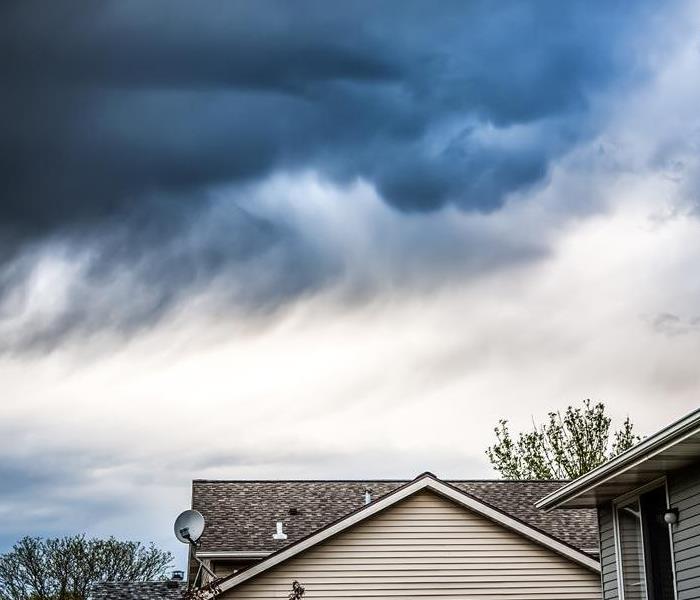 Taking the appropriate steps to prevent storm damage and minimize recovery is important to protect your property.
Taking the appropriate steps to prevent storm damage and minimize recovery is important to protect your property.
Natural disasters such as storms can cause significant damage to buildings and properties. If your building has been impacted by a storm, it's essential to take immediate action to assess and address any damage. Here are some steps to take after a storm.
Safety first
Ensure the safety of everyone in the building before attempting to assess the damage. If there are any hazards, such as downed power lines or gas leaks, evacuate the building and call the appropriate authorities.
Document the damage
Take photos or videos of the damage to provide evidence for insurance claims. Record the date and time of the damage and any relevant details, such as wind speeds or rainfall amounts.
Secure the building
Board up broken windows, tarp over damaged roofs, and secure any openings to prevent further damage or unauthorized entry.
Contact your insurance company
Contact your insurance provider as soon as possible to report the damage and begin the claims process. Provide them with photos and other documentation to support your claim.
Hire a professional restoration company
A professional restoration company can help assess the damage and develop a plan for restoring the building to its preloss condition. They can also help mitigate further damage and prevent mold growth.
Clean up debris
Remove any debris or fallen trees from the building's surroundings to prevent further damage or injuries. Take steps to prepare your building for future storms, such as reinforcing windows and doors, securing outdoor items, and trimming trees. Keep track of all expenses related to the storm damage, such as repairs, restoration costs, and temporary living arrangements. This will help with insurance claims and may be tax-deductible.
It's worth noting that some types of storm damage may not be immediately visible or apparent. For example, water damage may not become apparent until days or weeks after a storm, which can lead to mold growth and further damage. It's important to thoroughly inspect the building for any signs of damage, including water stains, musty odors, or warped walls or floors. If you suspect water damage, it's essential to contact a professional restoration company that specializes in water damage mitigation and restoration. They can help identify and address any underlying issues and prevent further damage to the building. By taking a proactive approach to storm damage, you can help ensure the safety and well-being of everyone in the building and minimize the long-term impact of the storm.
In conclusion, storm damage can be devastating, but taking these steps can help you minimize the damage and begin the process of recovery. By prioritizing safety, documenting the damage, contacting insurance, hiring professionals, cleaning up debris, keeping records, and preparing for future storms, you can help protect your building and its occupants.
A Storm Damage Preparation Plan for Commercial Structures
7/27/2022 (Permalink)
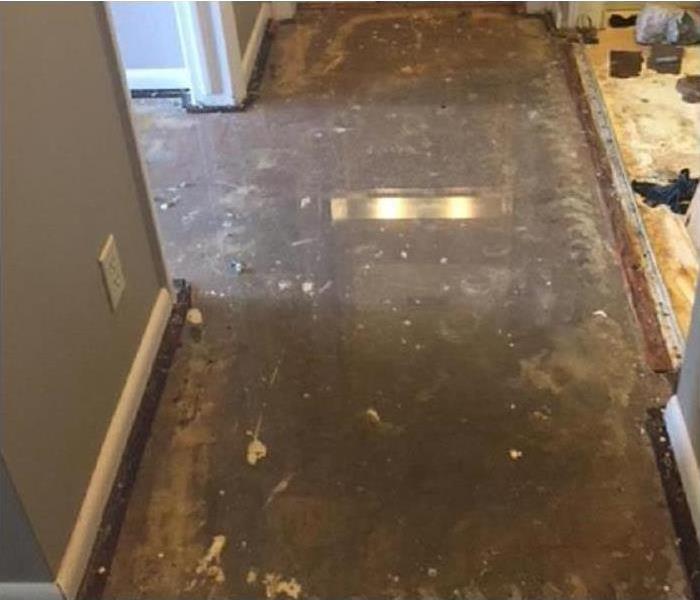 Flood damage to a Bluffdale building.
Flood damage to a Bluffdale building.
Storm Damage Prevention
The managers and owners of commercial buildings should make a plan to prepare for storms. Many methods for protecting property from adverse weather are long-term strategies that may not be possible to implement in the hours before a winter storm. From anticipating seasonal weather patterns to monitoring weather forecasts for Bluffdale, UT, building managers, and owners should take a proactive approach to storm damage prevention.
Watch the Weather
One of the easiest ways for property owners and managers to prepare for storms is to be aware of seasonal weather patterns and approaching storm systems. Here are a few of the most important types of weather events for which to look out:
- High winds
- Freezing temperatures
- Severe weather events
High winds have the potential to damage a structure and may accompany more severe weather events. Freezing temperatures may not seem as dangerous, but a frozen blockage may form in an exposed pipe and cause a pipe break that floods a structure.
Maintain Drainage
A longer-term storm preparation measure involves maintaining drainage. This can be helpful all year long, from allowing snow and ice to melt after a winter storm to keeping downspouts, drains and gutters clear for rainfall in other seasons.
Reduce Damage Risks
Property owners may want to invest in solutions for anchoring items kept outdoors such as chairs, tables or garbage cans. Any unsecured items can become flying debris that damages a property when wind speeds pick up. Storm windows might also be a worthwhile investment.
Some storm damage preparation methods involve investing in the infrastructure or maintenance of a commercial building in Bluffdale, UT. Other measures require immediate action based on changing weather conditions, such as keeping under-insulated pipes from bursting during a winter storm. A plan that accounts for short- and long-term preparations can go a long way toward limiting the severity of damage to a structure.
4 Reasons Your Business Should Have Flood Insurance
7/20/2022 (Permalink)
 If you live in an area with high flood risk, it can be a good idea to purchase the insurance
If you live in an area with high flood risk, it can be a good idea to purchase the insurance
4 Reasons Your Business Should Have Flood Insurance
When you acquire a building for your West Jordan, UT business, one of the first things you should do is purchase insurance. When you do this, there are several options available, so it can be difficult to determine what is the best choice for you. You may wonder if additional policies like flood insurance are worth the extra cost. In many cases, the answer is yes. Here are just a few reasons why.
1. Most Standard Insurance Does Not Cover Floods
While standard commercial insurance does cover a large range of situations, large-scale disasters such as floods and hurricanes are often not included. These can cost insurance companies a lot of money, so they will often require an additional policy for this added coverage.
2. Flooding Can Cause Extensive Damage
If your business is affected by a flood, you don’t want to be stuck paying for all the damage that is caused. Flood waters that are left to sit can cause warping to walls and flooring and weaken the structure of your building. They can also damage furniture, electronics, and other belongings. Because flood water can carry contaminants, bacteria, and mold spores, the cleanup can be quite costly as well.
3. It Might Be Required
In some areas, you might not have a choice as to whether or not you will buy flood insurance. If you live in an area with high flood risk and have a mortgage on your building, you might be required by the lender to purchase the additional policy.
4. Natural Disasters Can Be Unpredictable
Even if you live somewhere with a low risk of flooding, it can still be a good idea to purchase insurance. Storms and natural disasters can sometimes have unexpected results, so you might end up in an unpleasant situation if you aren’t prepared for the worst.
If you do experience flooding in your building, a water damage remediation company can help with cleanup and repairs. Having flood insurance will make the process easier while saving your business money.
3 Difficult Challenges of Cleaning Up After a Storm
6/8/2022 (Permalink)
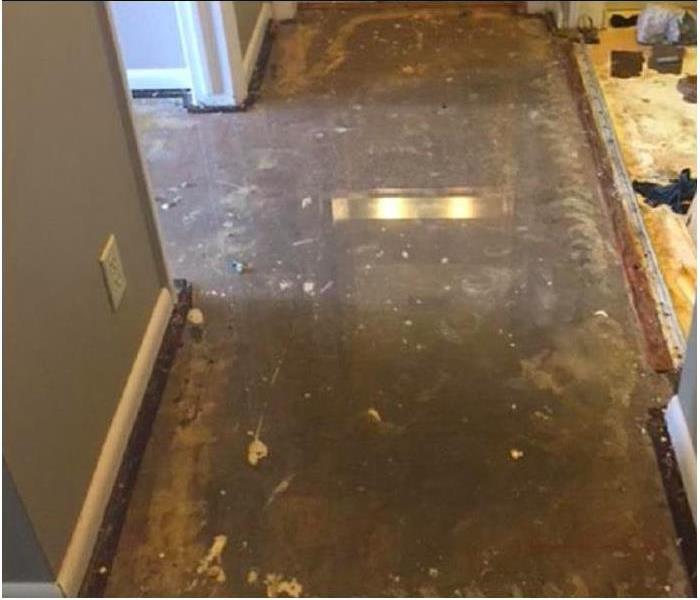 A West Jordan, UT home was flooded due to a storm
A West Jordan, UT home was flooded due to a storm
Cleaning Up After a Storm: 3 Difficult Challenges
If you have yet to experience a damaging storm at your home in West Jordan, UT, you should be aware that the process involves many complex factors.
Extensive flooding is among the most difficult situations to clean. It requires specialized equipment that most homeowners do not have, as well as technical expertise. A professional storm restoration company is often your best bet, as highly-trained technicians handle all aspects of storm recovery.
1. Limiting Water Damage
Many situations after a storm result in black water spreading through a home. Not only is this a potentially dangerous situation, but it is also likely to result in more extensive and quicker damage to the structure and contents of your home. The first step after flooding is water removal with industrial pumps and vacuums, followed by intensive drying using high-powered fans.
2. Cleaning Up Flood Damage
Whether water comes in through a faulty roof or overwhelms your foundation during heavy rains, it is critical to act quickly. Standing water will ruin fabrics and even break down wood structures in a matter of hours. Many advanced techniques are needed to restore your home to its original condition. These include tearing out ruined flooring, assessing wet insulation, and drying out saturated clothes and other personal items.
3. Preventing Mold Growth
When any type of moisture inundates your home, the risk of mold spread becomes much higher. After professional drying, proper cleaning, and sanitizing techniques, using approved products, are needed. This goes beyond ordinary cleaning and can keep mold in check. A poor process of cleaning and drying could allow mold to gain a foothold at some future date.
Any type of flooding in your home, even a break in a pipe that carries clean water, calls for a professional response. This will result in a faster cleanup and fewer problems down the road.
4 Ways To Prevent Flooding in Towns
4/26/2022 (Permalink)
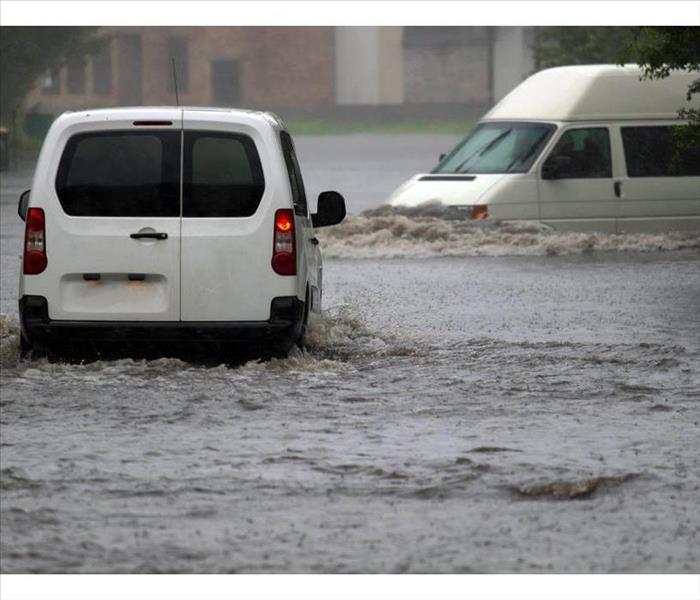 Flood prevention can play a major role in keeping people safe and reducing damage from heavy storms.
Flood prevention can play a major role in keeping people safe and reducing damage from heavy storms.
4 Methods For Preventing Flooding In Cities
Rain is a wonderful, natural way to water gardens and town landscaping. However, heavy storms and floods can cause plenty of damage to a town and the buildings within. With flood prevention planning, you can take measures to avoid excess damage in West Jordan, UT. Here are four ways to prevent flooding in small towns and cities.
1. Design the Drainage System
The design and layout of a town’s drainage system can build a great foundation for preventing floods and cause less headache over time. A drainage system should be well-mapped and properly covered to prevent leaves, debris and large items from clogging the system. Water should be able to drain freely and quickly to avoid pooling in streets and low-lying areas.
2. Plant Vegetation
While trees, shrubs and even different varieties of grass can be decorative and scenic, they serve an even greater purpose when it comes to flood prevention. Extra vegetation can absorb excess water into the soil and can prevent land erosion by slowing down heavy water flow.
3. Create Detention Basins
Also known as retarding basins, detention basins provide a pathway for water runoff and a temporary holding place for floodwaters. Vegetation and large rocks are often used to line the edges of the basin for additional absorption and to slow the rapid flow of water and prevent erosion.
4. Provide Education
It is important to educate people that live in the town and ensure they understand the importance of keeping drainage systems clear. This can help reduce the amount of litter and debris that clogs culverts and water ways. In addition to prevention, it is important to educate people on what to do if a flood occurs to stay safe and minimize damage. Providing contact information for a flood cleaning service can be helpful to businesses that are impacted by storms.
While rainwater can provide many benefits to a town, it can also cause severe damage if people are unprepared. Flood prevention can play a major role in keeping people safe and reducing damage from heavy storms.
Keep Your Employees Safe With Storm Preparedness
3/16/2022 (Permalink)
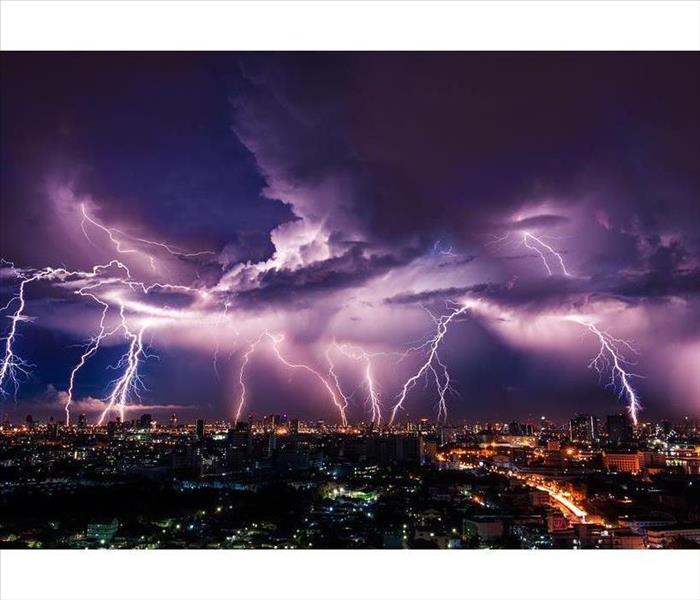 Every heavy rainstorm carries the risk of disaster. Make sure your employees are safe by taking precautions both before and after an attack.
Every heavy rainstorm carries the risk of disaster. Make sure your employees are safe by taking precautions both before and after an attack.
Storm Preparedness Can Keep Your Employees Safe
Keeping employees safe during a rain storm is the responsibility of every office manager. How you react to one is as important as the preparatory measures you take. Here are some extreme weather safety guidelines that should always be followed.
Thunderstorm Preparations
Before high winds and driving rains hit your office, reduce the risk of danger by employing these measures:
- Download an emergency weather app to your phone and turn on notifications
- Trim trees so that blown branches are less likely to break windows
- Install lightning rods with guidance from your local fire department
- Create an emergency first aid kit and inform everyone of where it is being stored
The danger presented by any heavy rain storm can be significantly reduced with the execution of these precautions.
Thunderstorm Responses
When a storm strikes, remain calm and take charge. The odds of someone getting injured are lower when you stay in control and are aware of what to do.
If a company picnic or other outdoor activity is underway when bad weather rolls in, immediately call off the event. Usher everyone inside, reminding them of the danger from lightning strikes. Transfer as much fun inside as possible to reduce the temptation of heading back out.
If conditions make re-entering your building impossible, avoid high ground, fences and sheds. Take shelter in another dwelling or a vehicle with the windows rolled up. Shutter your workspace's windows and secure the main entryways. Resist the temptation to constantly peer outside, as windswept items can shatter glass.
Shut down computers.
Instruct staff to avoid using telephones and other electrical equipment. If possible, temporarily replace these devices with battery-powered alternatives.
Only after the danger has passed should you concern yourself with how much damage has been sustained. Once you have taken stock of everything needing repair, get in touch with an office repair specialist and bring your workspace back to normal.
Every heavy rain storm comes with the potential for disaster. Make sure your staff stays safe by taking smart actions both before and after one arrives in South Jordan, UT.





 24/7 Emergency Service
24/7 Emergency Service





